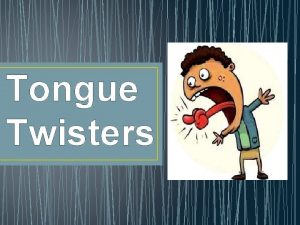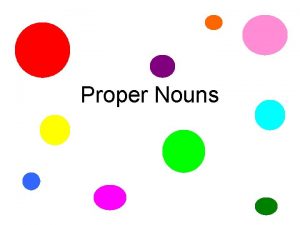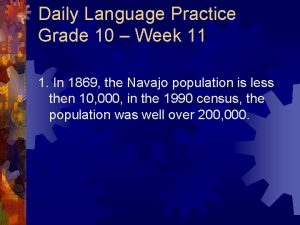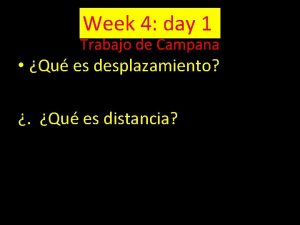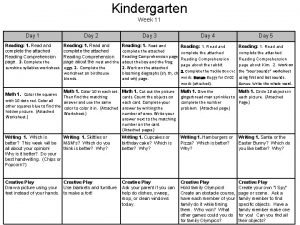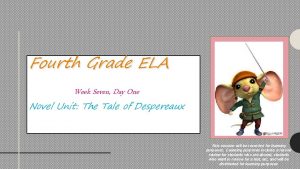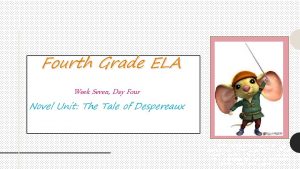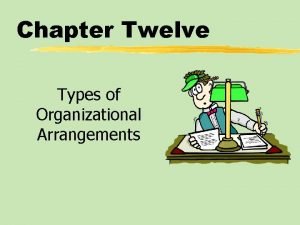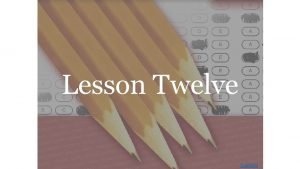D L P Week Twelve GRADE SEVEN Day
















- Slides: 16

D. L. P. – Week Twelve GRADE SEVEN

Day One – Skills • Indenting • A writer should indent (start a new line and move to the right five spaces) the beginning of a paragraph. When writing dialogue, indent with each new speaker. • Pronoun Usage – Case Pronouns are used differently depending on what case they are. Subject pronouns, also known as nominative pronouns can work as subjects or predicate nouns. They are I, we, you, he, she, it, and they. Objective pronouns can work as direct objects, indirect objects, or objects of the preposition. They are me, us, you, him, her, it, and them. Possessive pronouns show ownership. They are my, mine, ours, yours, his, hers, its, their, and theirs. Note that possessive pronouns do not have apostrophes. • Punctuation – Period in an Abbreviation When a word is abbreviated, a period must be used to show that the word has been shortened. (Mister – Mr. street – st. ) • Capitalization – Proper Nouns - Places Names of specific places must be capitalized since they are proper nouns. These could include the names of buildings and monuments. They could also include towns, cities, states, and countries.

DAY ONE – SENTE NCE ONE “Who is going to a new school? ” the teacher asked. “It is me, ” Ernesto wrote in the composition. “Who is going to a new school? ” the teacher asked. “It is I, ” Ernesto wrote in the composition.

DAY ONE – SENTE NCE TWO Mrs Dodson, a neighbor, told Ernesto how to find the lincoln school. Mrs. Dodson, a neighbor, told Ernesto how to find the Lincoln School.

Day Two – Skills • Punctuation – Foreign Words A word that is foreign should be underlined if handwriting or italicized if typing. • Punctuation – Hyphen Some compound words are connected by a hyphen. To be certain if a word needed a hyphen, consult a dictionary. Hyphens are also used at the end of a written or typed line of text if the complete word does not fit. Use the hyphen between syllables of the word.

DAY TWO – SE NTE NCE ONE Friends in the barrio explained the school rules.

DAY TWO – SE NTE NCE TWO Miss Hopley sat at a roll top desk and smiled wholeheartedly. Miss Hopley sat at a roll-top desk and smiled wholeheartedly.

Day Three– Skills • Punctuation – Quotation Marks – Direct Quotation marks are used around the exact words that someone speaks. Punctuation to separate the spoken and non-spoken words is included inside of the quotation marks. • Capitalization – Proper Adjectives describe nouns. When a proper noun is changed into an adjective form, then it must be capitalized. America is a proper noun, so when it becomes the adjective American, it must still be capitalized.

DAY THR EE – S ENTE NCE ONE Ito can read a sentence the teacher exclaimed! “Ito can read a sentence!” the teacher exclaimed.

DAY THR EE – S ENTE NCE TWO The korean, italian, and polish first graders all had similar moments of glory. The Korean, Italian, and Polish first graders all had similar moments of glory.

Day Four– Skills • Conjunctions connect words, phrases, or clauses; therefore, they should never begin a sentence. Coordinating conjunctions (and, but, or, for, nor, yet, so) and correlative conjunctions (either…or, neither…nor, whether…or, both…and, not only…but also) connect thongs that are equal. If they connect two sentences, they must have a comma before them. Subordinate conjunctions such as when, because, and if connect independent clauses with dependent clauses. • Sentence Combining – Using Coordinating Conjunctions Two sentences can be combined by using a comma and a coordinating conjunction (and, but, ore, for, nor, yet, so). • Agreement – Subject and Verb The subject and verb of a clause must agree in person and number. This involves something called conjugation. Every verb can be conjugated as to first person, second person, or third person and as singular or plural. Take the verb go. Use the nominative pronouns I, you, and he as singular and we, you, and they as plural. Make the verb go match the pronoun. “I go” means the verb is first person singular. “They go” makes it third person and plural. Note third person singular – “he goes. ” When an action verb is third person singular, it typically ends in an “s. ” Be careful to not let words between the subject and verb such as prepositional phrases sway the verb choice. • Capitalization – Proper Nouns – Things Names of specific things must be capitalized. They may be the names of products (Kleenex), holidays (Fourth of July), languages (French), or companies (Nike). When the noun is more than one word, follow the same rules for capitalizing words in a title.

DAY FOU R – SE NTE NCE ONE Ernesto enjoyed his studies. And he liked his teachers. Ernesto enjoyed his studies, and he liked his teachers.

DAY FOU R – SE NTE NCE TWO Learning english, as well as getting used to a new country, take time. Learning English, as well as getting used to a new country, takes time.

Day Five– Skills • Capitalization – Outlines The first word in each section of an outline must be capitalized. • Punctuation – Quotation Marks – Direct Quotation marks are used around the exact words that someone speaks. Punctuation to separate the spoken and non-spoken words is included inside of the quotation marks.

DAY FIVE – SE NTE NCE ONE The first part of my story outline looked like this: I. facts about Barrio Boy A. family B. school The first part of my story outline looked like this: I. Facts about Barrio Boy A. Family B. School

DAY FIVE – SE NTE NCE TWO “Well, I don’t know if I want to be a teacher” said Ernesto. “Well, I don’t know if I want to be a teacher, ” said Ernesto.
 Tongue twisters funny
Tongue twisters funny Day 1 day 2 day 3 day 4
Day 1 day 2 day 3 day 4 Seven twelve portfolio
Seven twelve portfolio Day 1 day 2 day 817
Day 1 day 2 day 817 Week by week plans for documenting children's development
Week by week plans for documenting children's development 7 deadly sins ritual
7 deadly sins ritual Sabbath day calendar
Sabbath day calendar Crayon proper noun
Crayon proper noun 5-a-day language review week 16 answer key
5-a-day language review week 16 answer key 4 day school week pros and cons
4 day school week pros and cons My favorite day is saturday
My favorite day is saturday Now upon the first day of the week
Now upon the first day of the week 5 a day language review week 11
5 a day language review week 11 Week 4 day 1
Week 4 day 1 Week 11 day 3
Week 11 day 3 Holy week day 1
Holy week day 1 Dgp week 11 answers
Dgp week 11 answers
